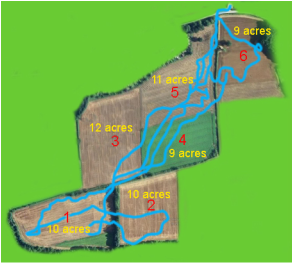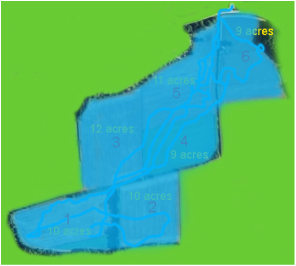We'd elected to carry out a recce on two 34 acre fields with no documented history whatsoever at our latest project, JHF1. At least the weather looked promising.
We kitted up to the sound of a great spotted woodpecker drumming, yellowhammers, chaffinches and skylarks singing their early spring songs. March hares were engaged in a bout of boxing, unaware it was still February!
The pass through the first field, which was in winter wheat, was fairly uneventfully with only a Roman grot and a penny of Edward I being unearthed. Green waste was a bit of a problem. As predicted, it took us the three hours to carry out the recce leaving at least another 48 hours remaining to complete the field, if that was an option at a later date.
The second field was even less eventful with nothing being recovered at all.
With that we decided to have a quick look at three more fields to assess their potential. Only one one showed some promise but as this was still in a rough ploughed state it would be later this year before we can fully assess its true weight.
With the green waste wearing down the morale we decided to drive to another permission for a breathe of fresh air ....and a little less earache!
A quick text to the landowner and it was off to an old favourite, TS2 of which we last visited in January 2015. This was only going to last an hour as the sunset was going to see to that.
We got there only to find that the main field with a Roman farmstead was still in rough plough! Luckily enough there was another field adjacent to it with winter wheat growing there.
A Roman coin was recovered within 2 minutes of arriving which was a relief. It wasn't long before 7 more Roman coins came to light, some of which were in a lovely condition.
With the sun setting and feeling hungry the next move was to finish up and find a nice pub with good food.
We managed to recover the ubiquitous hammered coin and 9 Roman coins, some in very nice condition, along with a few artefacts and a small amount of pottery. What was odd was that we managed to find three foreign coins from France, Germany and Spain!
It just goes to show that you can keep visiting your "favourite" fields but at the expense of never trying out new venues. Our compromise in this case worked well having shown that the "recce" fields will drop to the bottom of our list as regards a revisit. The other part of the compromise also worked out with 8 Roman coins being recovered in a very short space of time.
On the way home we spotted a car and would you believe it... its number plate was JHF1... how spooky!
The machines were set up with large coils (13" x 11") and using the standard GMP mode with auto tracking. As usual, all the recoveries came from a depth no deeper than 4 inches with most being two inches deep.
A couple of coke cans caught us out though at 14 inches!
Images of the days finds can be seen here and here.



 RSS Feed
RSS Feed
